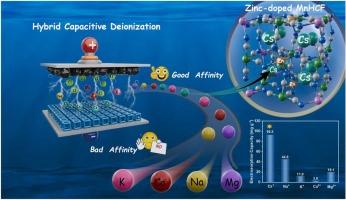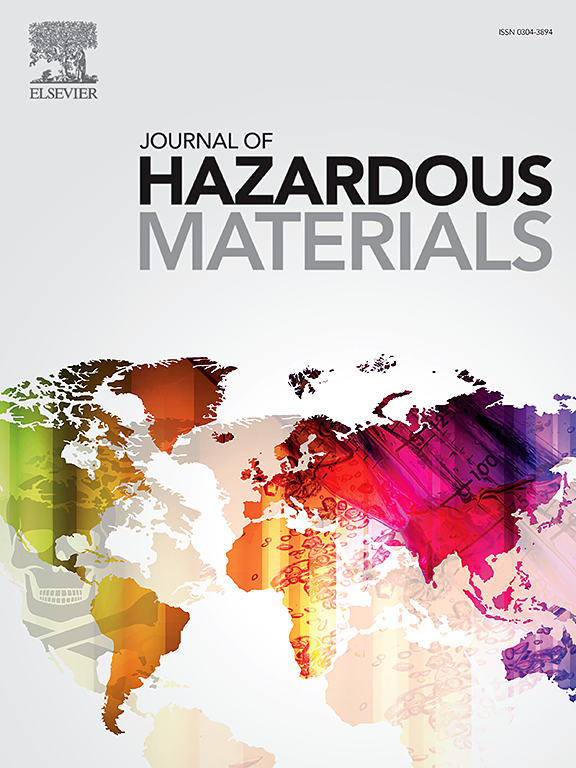Selective cesium extraction from highly saline solution using hybrid capacitive deionization with zinc-doped manganese hexacyanoferrate electrode
IF 11.3
1区 环境科学与生态学
Q1 ENGINEERING, ENVIRONMENTAL
引用次数: 0
Abstract
Recently, hybrid capacitive deionization (HCDI) has garnered significant attention for its potential in the selective extraction of cesium (Cs) from radioactive wastewater and salt lakes, which is crucial for resolving the supply-demand imbalance of cesium resources and eliminating radioactive contamination. However, developing HCDI electrodes capable of effectively separating and extracting Cs remains a significant challenge. In this work, we proposed an innovative strategy involving the doping of inactive metal ions to develop zinc-doped manganese hexacyanoferrate (ZMFC) as an HCDI cathode. This approach leveraged the synergistic effects of ion sieving of three-dimensional lattice and zinc doping to regulate electrochemical activity, enabling the selective electrochemical extraction of Cs+ ions from highly saline solutions. The optimized ZMFC-0.1 electrodes exhibited a maximum electrosorption capacity of 299.9 mg g–1 in a 400 mg L–1 Cs+ ion solution and maintained a high-capacity retention rate of 80.1 % after 50 consecutive absorption-desorption cycles in a 200 mg L–1 Cs+ ion solution. Moreover, ZMFC-0.1 showed a high selectivity coefficient of 27.4 at a Cs+/Na+ molar ratio of 1:40. Density functional theory (DFT) simulation revealed that manganese hexacyanoferrate (MnHCF) retains high stability and electrochemical activity following zinc atom doping. In-situ X-ray diffraction and theoretical calculations provided deeper insights into the mechanisms underlying reversible capacitive adsorption and selective Cs+ ion separation. The effectiveness of cesium selective extraction from brine in Xizang suggests that the ZMFC-0.1 electrodes hold significant promise for cesium recovery from salt lakes. This work presents a promising strategy for the electrochemical extraction of cesium from radioactive wastewater and salt lakes.

掺杂锌的六氰高铁酸锰电极杂化电容去离子从高盐溶液中选择性提取铯
近年来,混合电容去离子技术(HCDI)因其在放射性废水和盐湖中选择性提取铯的潜力而受到广泛关注,这对于解决铯资源供需失衡和消除放射性污染至关重要。然而,开发能够有效分离和提取碳的HCDI电极仍然是一个重大挑战。在这项工作中,我们提出了一种涉及掺杂活性金属离子的创新策略,以开发锌掺杂六氰高铁酸锰(ZMFC)作为HCDI阴极。该方法利用三维晶格离子筛分和锌掺杂的协同效应来调节电化学活性,实现了从高盐溶液中选择性提取Cs+离子。优化后的ZMFC-0.1电极在400 mg L-1 Cs+溶液中的最大电吸附容量为299.9 mg g-1,在200 mg L-1 Cs+溶液中连续50次吸解吸循环后保持80.1%的高容量保留率。在Cs+/Na+摩尔比为1:40时,ZMFC-0.1的选择性系数高达27.4。密度泛函理论(DFT)模拟表明,六氰高铁酸锰(MnHCF)在锌原子掺杂后保持了较高的稳定性和电化学活性。原位x射线衍射和理论计算为可逆电容吸附和选择性Cs+离子分离的机制提供了更深入的见解。西藏地区卤水中铯选择性萃取的有效性表明,ZMFC-0.1电极在盐湖中铯回收方面具有重要的应用前景。本研究为从放射性废水和盐湖中电化学提取铯提供了一种有前景的方法。
本文章由计算机程序翻译,如有差异,请以英文原文为准。
求助全文
约1分钟内获得全文
求助全文
来源期刊

Journal of Hazardous Materials
工程技术-工程:环境
CiteScore
25.40
自引率
5.90%
发文量
3059
审稿时长
58 days
期刊介绍:
The Journal of Hazardous Materials serves as a global platform for promoting cutting-edge research in the field of Environmental Science and Engineering. Our publication features a wide range of articles, including full-length research papers, review articles, and perspectives, with the aim of enhancing our understanding of the dangers and risks associated with various materials concerning public health and the environment. It is important to note that the term "environmental contaminants" refers specifically to substances that pose hazardous effects through contamination, while excluding those that do not have such impacts on the environment or human health. Moreover, we emphasize the distinction between wastes and hazardous materials in order to provide further clarity on the scope of the journal. We have a keen interest in exploring specific compounds and microbial agents that have adverse effects on the environment.
 求助内容:
求助内容: 应助结果提醒方式:
应助结果提醒方式:


